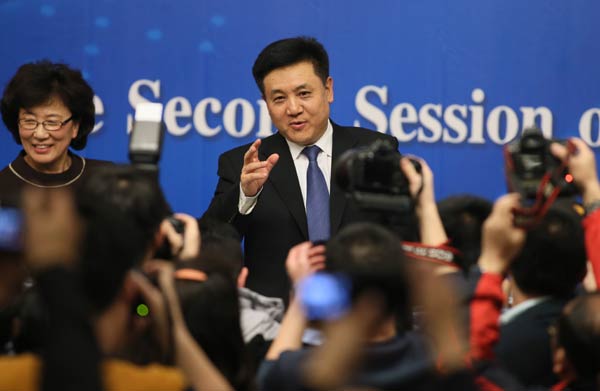

Vice-minister of environmental protection Wu Xiaoqing fields questions by reporters. Wang Jing / China Daily
Only three of China's 74 major cities met national air-quality standards last year, a senior official said on Saturday.
The government set PM2.5 limits for the first time in 2012. PM2.5 refers to particles smaller than 2.5 micrometers in diameter, which are considered extremely hazardous since they penetrate deeper into the lungs than larger particles.
Wu Xiaoqing, vice-minister of environmental protection, told a news conference during the ongoing NPC and CPPCC sessions that all the cities - except Hainan province's capital Haikou, Zhejiang province's Zhoushan and the Tibet autonomous region's capital Lhasa - exceeded the standard in 2013.
Beijing and its neighbors - Tianjin municipality and Hebei province - experienced the heaviest air pollution last year, when PM2.5 levels averaged 106 micrograms per cubic meter, ministry data showed.
"PM2.5, PM10 and ozone are the region's main pollutants," Wu said.
From Feb 20 to 26, smog enveloped 15 provinces and regions, covering more than 1.8 million square kilometers, according to the data.
The PM2.5 levels in Hebei's capital Shijiazhuang hit 612 micrograms per cubic meter on Feb 26 - about 17 times the national standard.
While the frequent smoggy days garnered headlines worldwide, top authorities showed determination to tackle air pollution. Premier Li Keqiang described smog as the "nation's red-light warning of inefficient and blind development".
China plans to eliminate outdated energy producers and industrial plants, which are air pollution's main sources.
This year, China will cut outdated steel-production capacity by 27 million tons and cement production by 42 million tons. About 50,000 small coal-fired furnaces will be shut down across the country, according to the government work report.
"With effective efforts to tackle pollution, our environment will become better," Wu said.
China announced new air-quality standards in March 2012 for ozone, carbon monoxide, PM2.5, sulphur dioxide, nitrogen oxides and large particulate matter. Figures are reported hourly by 496 monitoring sites in 74 cities.
The new standards will take effect nationwide before 2016.
But the country is not only looking at the skies. The government also plans to tackle water and soil pollution this year.
"Air pollution, water pollution and soil pollution are equally important issues," Wu said.
Wu added that soil pollution legislation will be accelerated.
The top legislator is also considering environmental-protection law amendments that will grant new powers to fine and punish violators.
A water-pollution action plan will be released this year, Wu said.
Environmental-protection investment surged to 1 trillion yuan ($163 billion) in 2013 from 603 billion yuan in 2011, the ministry's data showed.
"The investment will further increase this year," Wu said.
Air pollution hot issue online
2014-03-05Revised law to be even tougher on air polluters
2014-03-03Copyright ©1999-2018
Chinanews.com. All rights reserved.
Reproduction in whole or in part without permission is prohibited.